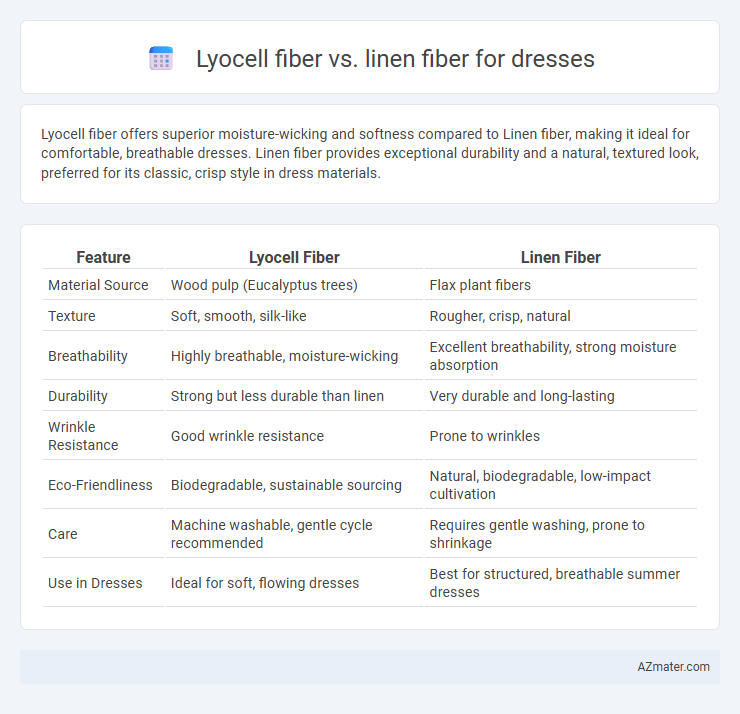Lyocell fiber offers superior moisture-wicking and softness compared to Linen fiber, making it ideal for comfortable, breathable dresses. Linen fiber provides exceptional durability and a natural, textured look, preferred for its classic, crisp style in dress materials.
Table of Comparison
| Feature | Lyocell Fiber | Linen Fiber |
|---|---|---|
| Material Source | Wood pulp (Eucalyptus trees) | Flax plant fibers |
| Texture | Soft, smooth, silk-like | Rougher, crisp, natural |
| Breathability | Highly breathable, moisture-wicking | Excellent breathability, strong moisture absorption |
| Durability | Strong but less durable than linen | Very durable and long-lasting |
| Wrinkle Resistance | Good wrinkle resistance | Prone to wrinkles |
| Eco-Friendliness | Biodegradable, sustainable sourcing | Natural, biodegradable, low-impact cultivation |
| Care | Machine washable, gentle cycle recommended | Requires gentle washing, prone to shrinkage |
| Use in Dresses | Ideal for soft, flowing dresses | Best for structured, breathable summer dresses |
Introduction to Lyocell and Linen Fibers
Lyocell fiber, derived from sustainably sourced wood pulp, offers exceptional softness, breathability, and moisture-wicking properties ideal for dress fabrics. Linen fiber, made from flax plants, is renowned for its durability, natural luster, and excellent heat conductivity, making it a preferred choice for lightweight, breathable dresses. Both fibers provide eco-friendly alternatives, with Lyocell emphasizing biodegradability and linen highlighting strong natural fiber resilience.
Origin and Production Process
Lyocell fiber is derived from sustainably sourced wood pulp, primarily eucalyptus, through a closed-loop solvent spinning process that recycles water and chemicals, minimizing environmental impact. Linen fiber originates from the flax plant, harvested and processed by retting, drying, and scutching to extract strong flax fibers that are traditionally beaten and spun into yarn. The Lyocell production emphasizes eco-friendly chemical recovery and uniform fiber quality, while linen production relies on natural fiber extraction and manual or mechanical preparation steps reflecting its ancient agricultural heritage.
Environmental Impact
Lyocell fiber, derived from sustainably harvested eucalyptus wood using a closed-loop production process, generates significantly less water pollution and has a lower carbon footprint compared to traditional linen, which is made from flax plants requiring extensive water and pesticide use. Linen production involves retting, a water-intensive process that can contribute to water contamination, while Lyocell's eco-friendly solvent recovery method minimizes harmful emissions and waste. Both fibers are biodegradable, but Lyocell's efficient manufacturing and renewable raw materials make it a more environmentally responsible choice for eco-conscious dress fabrics.
Breathability and Comfort
Lyocell fiber offers superior breathability due to its moisture-wicking properties, keeping the skin dry and comfortable in warm weather. Linen fiber is naturally breathable with excellent air permeability, allowing heat to dissipate quickly and providing a cool feel during wear. Both fibers contribute to comfort, but Lyocell's smooth texture feels softer against the skin, while linen has a crisp, textured finish that becomes softer over time.
Moisture Absorption and Wicking
Lyocell fiber exhibits exceptional moisture absorption and wicking properties, making it highly breathable and comfortable for dress fabrics. Compared to linen fiber, Lyocell can absorb more moisture--up to 50% of its weight--while efficiently transferring sweat away from the skin, promoting a dry feel. Linen, though breathable and moisture-wicking due to its natural flax composition, tends to dry slower than Lyocell, which impacts overall comfort in humid conditions.
Durability and Longevity
Lyocell fiber offers superior durability compared to linen, resisting wear and tear while maintaining its strength after multiple washes. Linen is known for its natural breathability and comfort but tends to weaken and develop wrinkles more quickly over time. For long-lasting dresses, lyocell provides better longevity due to its resilience and smooth texture that sustains fabric integrity.
Aesthetic Appeal and Texture
Lyocell fiber offers a smooth, silky texture and a luxurious sheen that enhances a dress's aesthetic appeal with a modern, polished look. Linen fiber features a natural, crisp texture with visible slubs, providing a rustic, breathable quality that adds character and casual elegance to dresses. The choice between Lyocell and Linen depends on the desired visual effect: Lyocell delivers sleek sophistication, while Linen imparts organic charm and textured depth.
Ease of Care and Maintenance
Lyocell fiber offers superior ease of care compared to linen, as it resists wrinkles and can be machine washed without special treatment, making it ideal for everyday dresses. Linen fiber requires more maintenance due to its tendency to wrinkle easily and typically needs gentle washing and ironing to maintain a crisp appearance. Lyocell's moisture-wicking and durability properties contribute to its low-maintenance advantages over linen in dress fabrics.
Cost and Affordability
Lyocell fiber generally offers a more affordable option for dress materials compared to linen due to its efficient production process and lower raw material costs. Linen, made from flax fibers, tends to be pricier because of labor-intensive harvesting and processing methods. For budget-conscious consumers, lyocell provides a cost-effective yet durable and breathable fabric choice for dresses.
Best Choice for Dresses: Lyocell or Linen?
Lyocell fiber offers superior softness, moisture-wicking, and breathability, making it ideal for comfortable, lightweight dresses that drape elegantly. Linen fiber excels in durability and a distinct textured appearance but tends to wrinkle easily and feels rougher against the skin. For dresses prioritizing comfort, smooth feel, and ease of care, Lyocell is the best choice.

Infographic: Lyocell fiber vs Linen fiber for Dress
 azmater.com
azmater.com